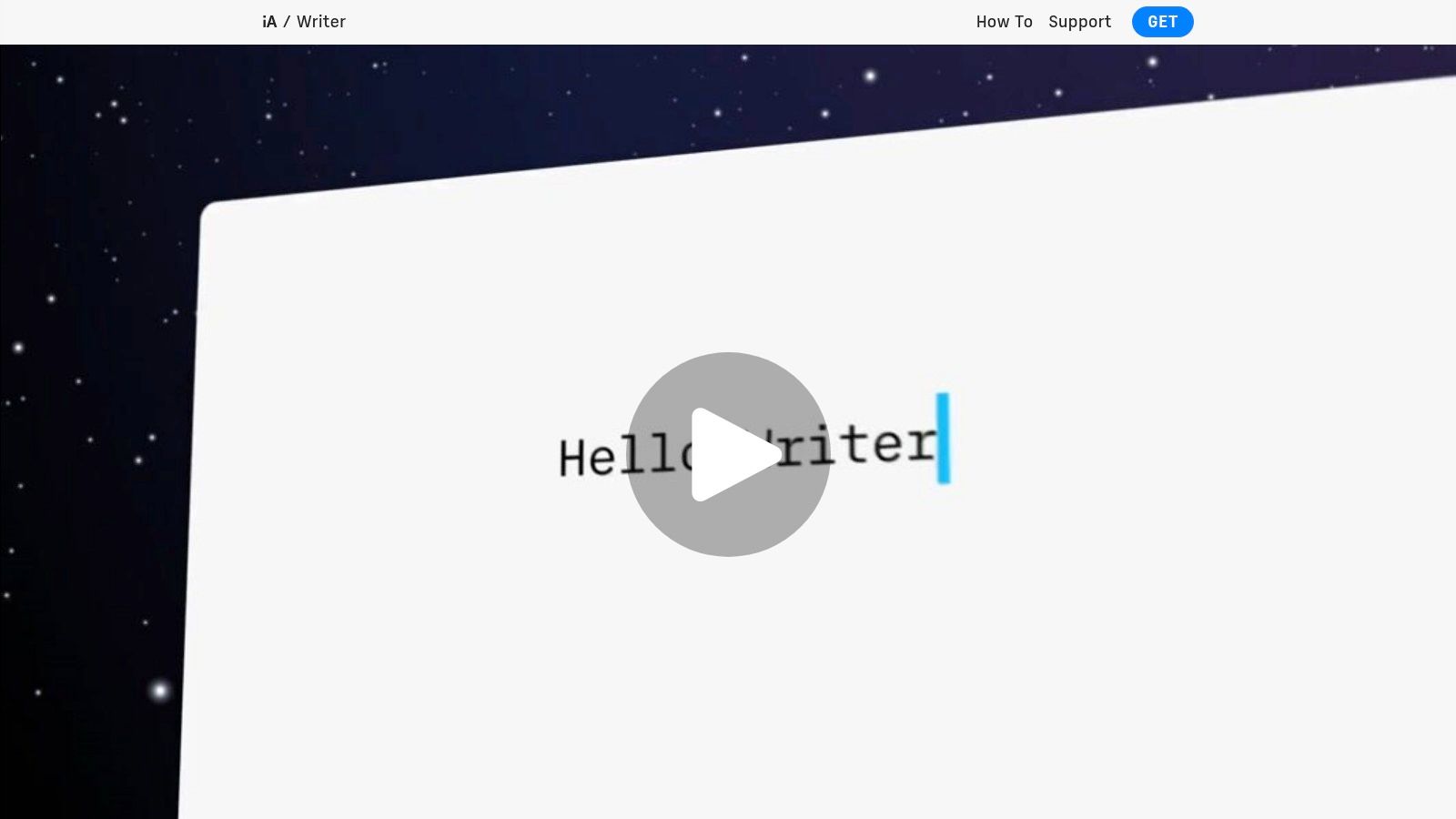- Published on
12 Best Online Writing Tools to Use in 2025
- Authors

- Name
- Tony
- @shyeditor
The right software can transform your writing process from a daunting task into a seamless creative journey. Whether you are a novelist weaving complex narratives, a blogger crafting engaging content, or an academic structuring a detailed thesis, the array of available online writing tools is vast. But how do you select the one that truly fits your specific needs? This comprehensive guide cuts through the marketing noise to deliver a practical analysis of the industry's leading options.
We will go beyond surface-level feature lists and dive deep into the practical applications, hidden strengths, and honest limitations of each platform. Beginning with the versatile Shy Editor, we'll explore how these tools integrate into different workflows, from initial brainstorming and organization to final polishing and AI-assisted refinement. This curated comparison is designed to help you identify the perfect digital partner for your craft. Prepare to find the software that will elevate your writing and streamline your entire creative or professional process.
1. ShyEditor: The All-in-One AI-Powered Writing Environment
ShyEditor earns its top spot by providing a unified, AI-enhanced writing environment that excels at organization and research-heavy projects. Unlike tools that are just a text editor with AI features, ShyEditor is built as a complete workspace. It's designed for writers who need to manage notes, sources, and complex ideas alongside their main draft.

Its standout feature is the integrated Knowledge Base, which allows you to keep track of important people, locations, and research notes all in one place, accessible directly from your editor. For academics and non-fiction writers, the built-in Bibliography and Citation manager is a game-changer, allowing you to automatically import sources and format citations in APA, MLA, and other styles. The AI assistant is designed to be a partner, helping you break through writer's block or refine your prose by adapting to your personal writing style. While the free tier is very capable for new writers, the Pro plan unlocks higher usage limits and more advanced AI capabilities.
Key Information:
- Best For: Novelists, academics, students, researchers, and bloggers who need strong organizational tools.
- Pricing: Offers a free tier with 20 AI credits/month and 100MB storage. The Pro plan is $10/month for 500 AI credits, 5GB storage, and advanced features.
- Pros: Excellent organizational tools (Knowledge Base, Notes, File Library), built-in academic citation management, adaptive AI assistant, and a clean Markdown editor.
- Cons: The free plan's AI credit and storage limits are modest; like all AI tools, outputs require human fact-checking and editing.
2. Grammarly: The Ubiquitous AI-Powered Proofreader
Grammarly has established itself as the go-to AI-powered writing assistant for millions, acting less as a creative partner and more as an ever-present, meticulous proofreader. It excels at refining finished or in-progress drafts by flagging errors in grammar, spelling, and punctuation. While other online writing tools focus on content generation, Grammarly's strength lies in its powerful post-writing analysis, ensuring clarity, correctness, and professionalism across any platform you use.

Its real power is realized through extensive browser and application integrations. The tone detector is a standout feature, providing real-time feedback on how your message might be perceived-from confident to friendly-which is invaluable for professional emails and client-facing communication. For students and academics, the built-in plagiarism checker is an essential safeguard. While the free version catches critical errors, upgrading to Premium unlocks advanced style, clarity, and fluency suggestions that truly elevate your writing. The constant internet requirement, however, means it's not a solution for offline work sessions.
Key Information:
- Best For: Students, professionals, bloggers, and anyone needing robust, real-time proofreading and editing across multiple platforms.
- Pricing: Offers a robust free version for basic grammar and spelling. Premium plans start at $12/month (billed annually) for advanced style, tone, and plagiarism checks.
- Pros: Extremely user-friendly with extensive integrations, provides excellent real-time feedback, and the tone detector is highly practical.
- Cons: The free version's suggestions are limited; an internet connection is required for it to function, and it doesn't offer content generation features.
3. ProWritingAid: The In-Depth Manuscript Editor
ProWritingAid positions itself not just as a grammar checker, but as a comprehensive writing mentor. Where other online writing tools might offer surface-level corrections, ProWritingAid provides over 20 distinct writing reports that analyze everything from sentence structure variety and pacing to sticky sentences and diction. This makes it an indispensable resource for authors looking to elevate their craft beyond basic grammatical correctness, offering a level of analytical depth that is hard to find elsewhere.

Its strength lies in its ability to provide granular, data-driven feedback. For instance, novelists can use the pacing report to identify slow sections in their manuscript, while non-fiction writers can use the "All Repeats" report to eliminate redundant phrasing. The robust integration with platforms like Scrivener and Google Docs allows writers to access these powerful reports directly within their preferred writing environment. While the sheer volume of data can feel overwhelming at first, mastering its reports provides unparalleled insight into one's writing habits and areas for improvement.
Key Information:
- Best For: Novelists, editors, and long-form writers who want deep, analytical feedback on their writing style and structure.
- Pricing: A free version is available with limitations. The premium subscription starts at $30/month or offers a lifetime deal, unlocking all reports and integrations.
- Pros: Extremely detailed reports on a wide range of writing metrics, excellent integration with Scrivener and other apps, affordable lifetime pricing option.
- Cons: The interface can be overwhelming for new users; processing large documents can sometimes be slow.
4. Hemingway Editor: The Champion of Clarity and Boldness
Hemingway Editor carves out its niche not as a comprehensive grammar checker, but as a ruthless personal trainer for your prose. This online writing tool is designed with a single-minded focus: to make your writing bold, clear, and direct. It doesn't get bogged down in nuance; instead, it uses a color-coded system to highlight specific areas for improvement. Sentences that are hard to read, instances of passive voice, overly complex words, and excessive adverbs are all flagged, forcing you to confront and simplify your language.
Its greatest strength lies in this targeted simplicity. By visually identifying common writing pitfalls, it trains you to self-edit more effectively over time. For writers who tend to overwrite or use academic jargon, pasting a draft into Hemingway provides an instant, unflinching diagnosis of where the text is weak or confusing. While it lacks the collaborative features of other platforms and its grammar capabilities are minimal, its value as a final polishing tool is undeniable. It excels at stripping away the fluff to reveal the strong, impactful core of your message.
Key Information:
- Best For: Bloggers, copywriters, journalists, and any writer aiming to improve the clarity and impact of their prose.
- Pricing: The online editor is free to use. A one-time purchase of $19.99 is available for a desktop app (Mac and Windows).
- Pros: Extremely easy to use, encourages concise and direct writing, provides a clear readability score, affordable one-time purchase for the desktop version.
- Cons: Not a comprehensive grammar or spell checker, no real-time collaboration or document storage features.
5. Scrivener: The Digital Studio for Long-Form Writers
Scrivener has cemented its reputation as the go-to application for writers tackling massive, structurally complex projects. Rather than a simple word processor, it acts as a comprehensive project management system built specifically for the chaos of long-form writing. It's one of the few online writing tools designed from the ground up to handle everything from initial brainstorming and research collection to the final compiled manuscript, making it a favorite among novelists, academics, and screenwriters who need more than a blank page.

Its core strength lies in the "Binder" and "Corkboard" features. The Binder allows you to break down a manuscript into manageable scenes, chapters, or sections, which can be rearranged with simple drag-and-drop actions. The Corkboard provides a visual overview with virtual index cards, perfect for plotting a novel or structuring a dissertation. You can edit scenes in isolation or view multiple documents side-by-side in a split-screen view, a feature invaluable for maintaining consistency. While it lacks the real-time cloud collaboration of other tools, its one-time purchase model is a major draw for writers wary of recurring subscriptions.
Key Information:
- Best For: Novelists, screenwriters, academics, journalists, and anyone writing a book-length or research-heavy project.
- Pricing: A one-time license purchase of $59.99 for macOS or Windows, with a 30-day free trial.
- Pros: Exceptional organizational tools for complex projects, powerful outlining and structuring features, one-time payment instead of a subscription.
- Cons: Has a significant learning curve; cloud syncing requires a third-party service like Dropbox and is not as seamless as browser-based tools.
6. Notion: The Ultimate Customizable Writing Workspace
Notion positions itself not just as a writing app, but as an all-in-one workspace where your writing lives alongside your research, planning, and project management. Its true power lies in its unparalleled flexibility. Where other online writing tools offer a fixed structure, Notion provides a blank canvas of "blocks" that you can assemble into anything from a simple blog post draft to a complex, multi-layered wiki for world-building a novel or managing a content calendar.

The standout feature for writers is its database functionality. You can create a database of articles, each with properties like status (draft, editing, published), author, and due date. This transforms a simple list of documents into a powerful, sortable project dashboard. While it supports real-time collaboration and Markdown, its core strength is organizing the entire ecosystem around a piece of writing. The initial setup can be daunting, but for those who need to build a bespoke system, no other tool comes close.
Key Information:
- Best For: World-building novelists, content teams, researchers, and anyone who needs to connect their writing to databases and project plans.
- Pricing: A generous free plan for personal use. Plus plan starts at $8 per user/month (billed annually) for more guests and a longer version history.
- Pros: Extreme customizability with databases and templates, consolidates multiple tools into one, excellent for organizing research and notes.
- Cons: Can have a steep learning curve and feel overwhelming; limited offline functionality can be a major drawback for some writers.
7. Google Docs: The Standard for Collaborative Writing
Google Docs has become the undisputed standard for real-time collaborative writing, earning its place on this list of essential online writing tools through its sheer accessibility and seamless integration. While it may not offer the specialized AI features of dedicated platforms, its strength lies in its simplicity and powerful collaborative core. It serves as a universal hub where teams can draft, edit, and comment on a document simultaneously, seeing every change as it happens.
Its standout feature is the frictionless collaboration model, backed by a robust version history that allows you to review and restore previous iterations of your work with a few clicks. This makes it a safety net for fast-moving projects. For writers and teams embedded in the Google ecosystem, its integration with Drive, Sheets, and Slides is a major productivity advantage. If Google Docs is your collaborative hub, discover how to further optimize your workflow with these top Google Workspace productivity tools. While an internet connection is needed for live collaboration, its offline mode provides a reliable fallback for solo work.
Key Information:
- Best For: Teams of writers, students, editors, and anyone needing straightforward, real-time document collaboration.
- Pricing: Free to use with a Google account. Business plans are available through Google Workspace subscriptions.
- Pros: Completely free, industry-leading real-time collaboration, accessible from any device, robust version history.
- Cons: Requires an internet connection for full functionality; formatting options are less advanced than desktop software like Microsoft Word.
8. Jasper AI: The High-Speed Content Generation Engine
Jasper AI positions itself as a premium AI writing assistant focused on speed and versatility, making it a go-to tool for marketers, bloggers, and businesses needing to produce content at scale. It excels at generating marketing copy, social media posts, and blog articles through a vast library of pre-built templates. By providing a few key inputs, users can rapidly create first drafts, ad copy, or product descriptions that are often surprisingly coherent and on-brand.
Its integration with Surfer SEO is a particularly powerful feature for content marketers, allowing them to optimize articles for search engines directly within the Jasper interface. This synergy helps bridge the gap between creation and performance. The rise of tools like Jasper represents a significant shift towards automated content creation, enabling teams to streamline their workflows and dramatically increase output, though a human touch is still essential for fact-checking and refining the final product.

Key Information:
- Best For: Marketing teams, social media managers, and content creators focused on high-volume production of short-form to medium-form content.
- Pricing: Purely subscription-based. Plans start at $39/month (billed annually) for the Creator tier, with more expensive tiers for teams and businesses.
- Pros: Dramatically speeds up the content creation process, user-friendly interface with helpful templates, strong SEO and marketing-focused features.
- Cons: Can be expensive, requires careful fact-checking and human editing for accuracy and voice, less suited for long-form creative or academic writing.
9. Copy.ai: The Rapid-Fire Marketing Copy Generator
Copy.ai positions itself as a go-to solution for marketers and entrepreneurs who need to produce high volumes of short-form copy quickly. Rather than focusing on long-form content like a novelist's editor, it excels at generating targeted marketing materials. With a vast library of over 90 templates for everything from Facebook ads and product descriptions to blog intros and email subject lines, it's one of the most versatile online writing tools for commercial content creation.

Its core strength lies in its simplicity and speed. Users input a brief description of their product or service, select a desired tone (e.g., professional, witty, adventurous), and the AI produces multiple variations in seconds. This process is ideal for A/B testing ad copy or brainstorming social media hooks. While the generated text often serves as a strong first draft, it typically requires a human touch for fact-checking and brand voice alignment, as outputs can sometimes be generic or require minor edits for complete accuracy.
Key Information:
- Best For: Social media managers, e-commerce store owners, digital marketers, and copywriters needing to overcome writer's block for short-form content.
- Pricing: Offers a free plan with a 2,000-word limit. Paid plans start at $49/month for unlimited words, more projects, and priority support.
- Pros: Extremely fast content generation, simple and intuitive interface, extensive template library for specific marketing needs.
- Cons: Generated copy often needs manual editing and fact-checking; less effective for nuanced or long-form content.
10. Writesonic: Rapid-Fire AI Content Generation for Marketers
Writesonic secures its spot as a powerhouse for speed and efficiency, particularly for marketers and entrepreneurs who need quality content at scale. While other online writing tools focus on long-form creative or academic writing, Writesonic excels at generating marketing-specific assets. It's a go-to platform for producing SEO-friendly blog posts, high-converting ad copy for platforms like Facebook and Google, and persuasive product descriptions in minutes, not hours.

Its key strength lies in its template-driven workflow. Instead of a blank page, you start with a specific goal, like "AI Article Writer 5.0" or "Landing Page Generator." This guided approach simplifies the creation process, making it accessible even for those new to AI content tools. The direct WordPress integration is a significant advantage for bloggers, allowing for seamless publishing. However, while the output is a strong first draft, it often requires a human touch for fact-checking and refining the brand voice to avoid a generic feel.
Key Information:
- Best For: Bloggers, digital marketers, e-commerce store owners, and social media managers needing to produce content quickly.
- Pricing: Offers a limited free trial. Paid plans start around $13/month (billed annually) for individuals and scale up for teams and businesses.
- Pros: Extremely fast content generation across various formats, very user-friendly interface, direct WordPress integration.
- Cons: Generated content consistently requires manual editing and fact-checking; the free version is quite restrictive.
11. QuillBot: AI-Powered Paraphrasing and Clarity Enhancement
QuillBot has established itself as a go-to tool for writers looking to refine their prose rather than generate it from scratch. It is primarily an AI-powered paraphrasing tool designed to help you rewrite sentences and paragraphs to improve clarity, tone, and style. Its strength lies in offering multiple modes, from "Standard" for simple rewording to "Creative" for more significant transformations, making it a versatile asset for academics fighting unintentional plagiarism or marketers adapting copy for different platforms.

Beyond its core paraphrasing function, QuillBot bundles several other useful online writing tools, including a grammar checker, a summarizer for condensing long texts, and a citation generator. This suite makes it particularly valuable for students and researchers. While QuillBot excels in paraphrasing, you can also explore other options like a free AI rewording generator for quick text rephrasing. The free version is quite capable for basic tasks, but the premium subscription unlocks higher character limits and more advanced rewriting modes. Learn more about using QuillBot as a rewording tool.
Key Information:
- Best For: Students, academics, non-native English speakers, and content creators focused on rephrasing and improving existing text.
- Pricing: Offers a limited free version. Premium plans start around $8.33/month (billed annually) for unlimited words and advanced features.
- Pros: Excellent for enhancing writing clarity and avoiding repetition, user-friendly interface with multiple rewriting modes, affordable pricing.
- Cons: The free version has significant limitations on character count; paraphrased text may still require manual editing for nuance and flow.
12. IA Writer: The Minimalist's Sanctuary for Focused Writing
IA Writer champions the philosophy that a clear screen fosters a clear mind, making it one of the most respected online writing tools for purists. It strips away the clutter of complex menus and formatting palettes, presenting a clean, digital canvas designed for one thing: writing. This deliberate simplicity is its greatest strength, offering a focused environment where the words themselves are the priority. It’s built for writers who find traditional word processors distracting and value a direct path from thought to text.
Its standout feature is the "Focus Mode," which fades out everything except the current sentence or paragraph, pulling your attention to the immediate task. This is incredibly effective for eliminating writer's block and encouraging a steady flow of prose. Combined with robust Markdown support, it allows for clean, structured writing without ever lifting your hands from the keyboard. For academics and bloggers, the ability to highlight different parts of speech (nouns, verbs, adjectives) helps refine sentence structure and eliminate fluff, tightening the final piece for maximum impact. While it lacks the collaborative and AI-driven features of tools like ShyEditor, its mastery of the core writing experience is unmatched.

Key Information:
- Best For: Journalists, bloggers, academics, and any writer who values a distraction-free environment and a Markdown-first workflow.
- Pricing: A one-time purchase, typically around $29.99 - $49.99 depending on the platform (macOS, Windows, iOS, Android). No subscriptions.
- Pros: Exceptional distraction-free interface, powerful Focus Mode, excellent Markdown support, and a single, affordable purchase for a lifetime license.
- Cons: Very limited formatting options, no real-time collaboration features, not suitable for projects requiring complex layouts or team input.
Finding Your Perfect Writing Partner: Making the Final Choice
We've explored a comprehensive landscape of the best online writing tools available today, from advanced grammar checkers and AI content generators to robust project management platforms. The journey through these twelve distinct options, from the all-encompassing power of ShyEditor to the focused simplicity of IA Writer, reveals a crucial truth: the perfect tool is not a universal solution. Instead, it's a deeply personal choice that hinges on your specific needs, your writing style, and the nature of your projects.
The key takeaway is to move beyond searching for a single "best" tool and instead focus on building your ideal writing stack. A novelist might draft their manuscript in ShyEditor's distraction-free environment, then import chapters into ProWritingAid for an in-depth stylistic and grammatical audit. A content marketer, conversely, could use Jasper AI to brainstorm blog post outlines and then use Grammarly to ensure brand voice consistency across all drafts.
Implementing Your New Tools
Once you've identified potential candidates, the next step is practical implementation. Nearly every tool on this list offers a free version or a trial period. Use this opportunity to test your top choices with a real-world project. See how the tool integrates into your existing workflow. Does it feel intuitive and empowering, or clunky and frustrating? The goal is to find a platform that feels less like software you have to operate and more like a natural extension of your creative process.
Ultimately, the right online writing tools are the ones that get out of your way, removing friction and allowing your ideas to flow onto the page. They should serve as a silent partner, handling the technicalities of organization and mechanics so you can focus on what truly matters: the art of writing itself. Experiment, combine, and customize your toolkit until you've built the perfect support system to help you achieve your writing goals.
Ready to see how a truly integrated platform can transform your writing process from initial idea to final polished draft? For writers who crave a unified space that combines AI-powered assistance with powerful project management, ShyEditor is the definitive solution. Experience the future of writing by creating your free account at ShyEditor today.